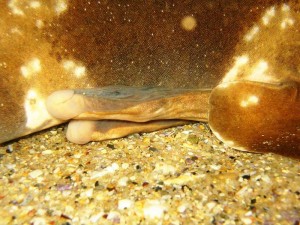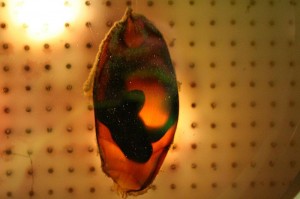As many of our readers prepare for a romantic evening with their special someone (or a Single’s Awareness Day celebration with friends), I invite you to take a few minutes and learn how our toothy friends in the ocean do it. And by “do it”, I mean “do it”. Here are 10 things you might not have known about shark sex.
1) Sharks have external reproductive organs. A male shark has reproductive organs called “claspers” (yes, there are two of them), and females have a “cloaca”. As I regularly tell the high school students who join us for shark research trips, even if you don’t have a degree in marine biology, you’ll quickly recognize what you’re looking at.

2) Sharks have internal fertilization, via copulation. Unlike bony fish which reproduce by spawning (i.e. releasing enormous clouds of eggs and sperm into the water), sharks are fertilized internally. Once again, you’d recognize what you were looking at. And in case you were wondering why “claspers” got their name (and, let’s face it, you were), the name is because once inside the female, they open up and clasp on, making sure the female can’t escape until the male has released his sperm.

3) Female sharks of many species have thicker skin than males, because males bite them during copulation. This biting is a necessary consequence of attempting copulation in a three-dimensional environment. It ensures that the male remains close enough to the female to copulate.
httpv://www.youtube.com/watch?v=vZUqPMF6GrA
4) Some sharks give live birth. It’s called “vivipary”. Newborn sharks have very pronounced umbilical scarring.
httpv://www.youtube.com/watch?v=zJbKbwuXij4
5) Some sharks lay eggs. The egg cases of “oviparous” sharks are come in many shapes, sizes and colors, and are often distinctive enough to identify what species of shark they came from.
httpv://www.youtube.com/watch?v=-TFDcFgJpNo

httpv://www.youtube.com/watch?v=PXVliaR1Q10
6) Some sharks have a strange mixture of live birth and laying eggs. So-called “ovovivipary” is complex, but can be thought of as growing inside an egg, but the hatching from that egg while still inside the mother.
7) Some sharks can reproduce without the aid of a male. It’s called “parthenogenesis”, and has been seen in several species kept in aquariums without males of their species. DNA tests confirm that the baby sharks are genetically identical to their mothers.
8) If a female mates with multiple males, baby sharks from the same litter will have multiple fathers. For example, genetic tests performed on a littler of lemon sharks in 1998 showed that the mother had mated with at least three males.
9) Sharks take a relatively long time to become reproductively mature. In some cases, more than 10 years!
10) Sharks have relatively few offspring, relatively infrequently. Many bony fish can produce tens or hundreds of thousands of eggs each year. In contrast, many species of sharks have fewer than a dozen offspring at a time. The record of approximately 300 whale shark embryos found in a female still falls far short of the average bony fish reproductive rate. Additionally, some species of sharks can only reproduce every two or even three years.

Happy Valentine’s Day!
References
Joung, S., Chen, C., Clark, E., Uchida, S., & Huang, W. (1996). The whale shark, Rhincodon typus, is a livebearer: 300 embryos found in one ?megamamma? supreme Environmental Biology of Fishes, 46 (3), 219-223 DOI: 10.1007/BF00004997
Feldheim, K., Gruber, S., & Ashley, M. (2001). Multiple Paternity of a Lemon Shark Litter (Chondrichthyes: Carcharhinidae) Copeia, 2001 (3), 781-786 DOI: 10.1643/0045-8511(2001)001[0781:MPOALS]2.0.CO;2
McCauley, D., Papastamatiou, Y., & Young, H. (2010). An Observation of Mating in Free-Ranging Blacktip Reef Sharks,
Pacific Science, 64 (2), 349-352 DOI: 10.2984/64.2.349
Chapman, D., Shivji, M., Louis, E., Sommer, J., Fletcher, H., & Prodöhl, P. (2007). Virgin birth in a hammerhead shark Biology Letters, 3 (4), 425-427 DOI: 10.1098/rsbl.2007.0189
Castro, J. (2000). Book Review:Life in the Slow Lane: Ecology and Conservation of Long-Lived Marine Animals John A. Musick The Quarterly Review of Biology, 75 (4) DOI: 10.1086/393692


This post is great, David! It gives a basic understanding of how sharksreproduce in 10 easy steps. If we could get the world’s fisheries managers to read this post, my job would be easier.
Thanks! I didn’t emphasize the conservation angle, but it’s easy to see how numbers 9 and 10 in particular have an impact on the kind of fishing pressure that sharks can withstand.
I’ve been working on an NPOA for a country which I shall not identify The first draft made 6 references to shark spawning and the rest of the document assumed that sharks multiplied at the same rate as tuna. That’s a big mistake. When you take into account how sharks actually reproduce, which for the most part is not done globally, it completely changes how we manage them.
Surprised you didn’t mention oophagy, in which the embryos eat each other in the womb. Good times.
Thanks David.
Most of us have no idea about how our ocean friends live, and I believe we should continue learning throughout our lives. Most especially we scuba divers have an obligation to understand aquatic life in order to help preserve their environment – both for the various species that live there, and for our future generations.